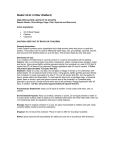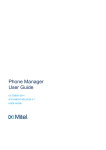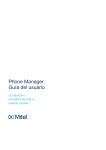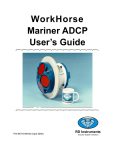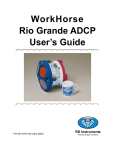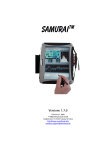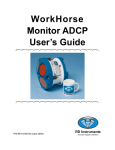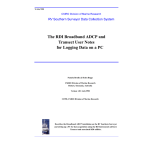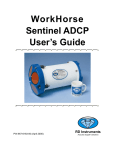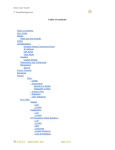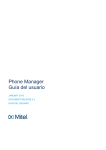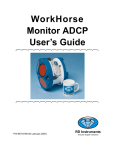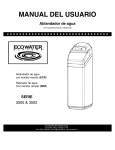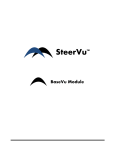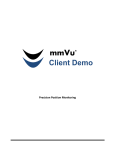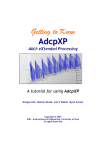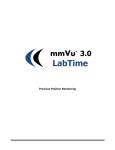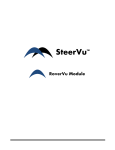Download User`s Guide
Transcript
RD Instruments Acoustic Doppler Current Profilers Ocean Surveyor User’s Guide RD INSTRUMENTS 9855 Businesspark Ave. San Diego, California 92131 (619) 693-1178 FAX (619) 695-1459 Internet [email protected] Field Service - [email protected] FTP - ftp.cts.com/pub/rdifs http://www.rdinstruments.com Copyright © 1998 by RD Instruments - All rights reserved. Except as permitted under the copyright act of 1976, no part of this publication may be reproduced or distributed in any form or by any means, or stored in a data base or retrieval system, without the prior written permission of RD Instruments. This manual is licensed for use with RD Instruments products only. P/N 95A-6002-00 (September 1998) Table of Contents 1 Introduction........................................................................................................................1 2 Setup the ADCP .................................................................................................................1 3 System Interconnection....................................................................................................2 4 4.1 4.2 4.3 4.4 4.5 4.6 4.7 4.8 4.9 TRANSECT Setup ..............................................................................................................6 TRANSECT Communication Menu .....................................................................................7 TRANSECT Calibration Menu Setup.................................................................................11 TRANSECT Planning Menu Setup....................................................................................13 Reference Layer Calculation .............................................................................................15 Automatic Reference Changing.........................................................................................16 Saving the Configuration File.............................................................................................16 Sample TRANSECT Configuration File.............................................................................17 Using NAVSOFT with TRANSECT....................................................................................19 NAVSOFT Enhancements.................................................................................................19 Variable Field Length Decoding.........................................................................................19 Averaging Interval Change ................................................................................................20 5 Deploy the ADCP .............................................................................................................21 5.1 Physical Inspection ............................................................................................................21 5.2 Vessel Mount Special Considerations ...............................................................................22 5.3 Test the ADCP...................................................................................................................23 6 Using Transect to Collect Data ......................................................................................23 6.1 Setting the Time ................................................................................................................23 6.2 Collecting Data ..................................................................................................................24 6.3 TRANSECT Acquire Menu Setup......................................................................................24 7 Recovering the ADCP......................................................................................................26 8 Backup the Data ..............................................................................................................26 9 TRANSECT Playback Menu ............................................................................................27 10 Using NAVMERGE ...........................................................................................................29 NAVMERGE Parameters ..............................................................................................29 Required Parameters ...................................................................................................29 Optional Parameters.....................................................................................................29 Examples ......................................................................................................................30 10.2 NAVMERGE Syntax Rules............................................................................................30 10.3 Tabular Output Data......................................................................................................31 10.4 GPS Time......................................................................................................................31 10.5 Exiting NAVMERGE ......................................................................................................31 10.6 Adding Navigation Data to TRANSECT Processed Data Files.....................................32 10.1 11 11.1 11.2 11.3 11.4 11.5 11.6 12 Using BBLIST...................................................................................................................33 Starting BBLIST.............................................................................................................33 BBLIST Menus ..............................................................................................................33 Using BBLIST to Convert Files......................................................................................34 Using a BBLIST Format File to Convert Files ...............................................................35 Report File.....................................................................................................................38 BBBATCH Program ......................................................................................................39 Preparing the ADCP for Storage ....................................................................................39 List of Figures Figure 1. Ocean Surveyor Connections...........................................................................................4 Figure 2. Ocean Surveyor Electronics Chassis ...............................................................................5 Figure 3. TRANSECT Main Menu ...................................................................................................7 Figure 4. TRANSECT Communication - ADCP Menu.....................................................................7 Figure 5. TRANSECT Communication - Ensemble Out Menu........................................................9 Figure 6. TRANSECT Communication - Navigation Menu..............................................................9 Figure 7. TRANSECT Communication - External Menu ...............................................................10 Figure 8. TRANSECT Communication - Reference Out Menu .....................................................10 Figure 9. TRANSECT Communication - Summary Menu .............................................................11 Figure 10. TRANSECT Calibration - Offsets Menu .......................................................................12 Figure 11. TRANSECT Calibration - Scaling Menu.......................................................................13 Figure 12. TRANSECT Planning - Setup Menu ............................................................................14 Figure 13. TRANSECT Planning - ADCP Non-Expert Menu.........................................................15 Figure 14. TRANSECT Planning - ADCP Expert Menu ................................................................15 Figure 15. Beam Clearance Zone .................................................................................................22 Figure 16. TRANSECT Acquire - Info Screen ...............................................................................24 Figure 17. TRANSECT Acquire - Data Collection Screen.............................................................25 Figure 18. TRANSECT Acquire - Scales Menu.............................................................................26 Figure 19. TRANSECT Playback - Processing Menu ...................................................................27 Figure 20. TRANSECT Playback Menu ........................................................................................28 Figure 21. TRANSECT Playback - Estimate Side Menu ...............................................................28 Figure 22. BBLIST Display ............................................................................................................34 Figure 23. Set the Processing Parameters....................................................................................36 Figure 24. Set the Conversion Limitations and Parameters ..........................................................36 Figure 25. Define Format Selection Menu.....................................................................................37 Figure 26. Defining the Format......................................................................................................37 Figure 27. View the Format before Converting..............................................................................37 1 Introduction Thank you for purchasing the RD Instruments (RDI) Ocean Surveyor Acoustic Doppler Current Profiler (ADCP). This booklet is designed to help first time ADCP users to unpack, set up, test, and send deployment commands to their ADCP. This booklet should be used with the Ocean Surveyor Technical Manual. Where needed, there are references to detailed information and figures contained in the Ocean Surveyor Technical Manual. For example, the reference (Figure A-1) would be found in the Ocean Surveyor Technical Manual in Appendix-A. Ocean Surveyor vessel-mount deployments are Real-Time. Real-Time use refers to the fact you are viewing the data as the ADCP collects it via a personal computer. This data is also stored on the computer to allow for data playback and processing at a later time. 2 Setup the ADCP As a minimum, you need the following equipment to set up the Ocean Surveyor system (see Figure 1). NOTE. Cable descriptions referenced figures are shown in Appendix-A of the Ocean Surveyor Technical Manual. ♦ Ocean Surveyor – Contains the beam former transducer circuitry and optional TCM2 compass. ♦ Electronics Chassis 1. Contains all interfaces to/from the ADCP, computer/terminal, vessel gyros, and power. 2. Allows either RS-232 (< 50 m) or RS-422 (> 50 m) computer-to-ADCP communications. 3. Converts vessel-gyro heading and tilt analog signals into digital data to be used for ADCP heading, pitch, and roll. Our TRANSECT program supports this data. The string format of the optional gyro-signal output from the electronics chassis is: $PRDID, ±ppp.pp, ±rrr.rr, hhh.hh (where p is pitch, r is roll, and h is heading; all scaled in degrees). ♦ Transducer Cable – Connects the ADCP transducer to the main signal-processing electronics chassis (Figure A-3). ♦ Serial Cable – RS-232 (J4) or RS-422 (J3) from the electronics chassis to the computer/terminal (Figure A-4). ♦ Computer – A computer running a terminal emulator programsuch as RDI’s BBTALKor a real-time processing program such as TRANSECT. Recommended minimum requirements for the computer: 80386 CPU, 18-MHz clock speed, EGA monitor, hard drive, and floppy drive. RDI programs support the following communication ports: Ocean Surveyor User’s Guide 1 (1). COM1, IRQ4, addresses 3F8 through 3FF (3). COM3, IRQ5, addresses 3E8 through 3EF (2). COM2, IRQ3, addresses 2F8 through 2FF (4). COM4, IRQ7, addresses 2E8 through 2EF You also can connect the following equipment: ♦ External Gyrocompass – Supplies synchro/stepperheading information and/or synchro pitch and roll information to the chassis for conversion before transmission to the computer for processing. Chapter 7 lists gyro requirements. ♦ External Navigation Device – Supplies serial, ASCII navigation data to the computer (Figure A-6) via our TRANSECTand NAVSOFTprograms. See the TRANSECT manual for requirements. This is an option for some ADCP applications. Users working in areas where bottom-track detection is not possible need this equipment in order to remove ADCP (Ship) motion from the data. ♦ External Ensemble-Out Device – Receives serial, ASCII ensemble data from the computer (Figure A-7) via our TRANSECT program. See the TRANSECT manual for requirements. This is an optional output from TRANSECT. This can be used to send ADCP data to other equipment on the ship. 3 System Interconnection Use Figure 1 and Figure 2, and the following steps to connect the system. a. Turn OFF or disconnect all power to all ADCP system equipment. CAUTION. Check the I/O cable and connector carefully for water before applying power. Even a small amount of water in the connector will cause serious damage to the ADCP. When connecting the I/O cable to the ADCP, do not over tighten the connector. The watertight seal is achieved by the o-rings on the bore and face of the connector. This seal does not require extreme force. Never use tools to tighten the connector. b. Use Figures 2 and 3 to connect the ADCP I/O cable, electronics chassis, RS-232/422 serial cable, computer/terminal, and gyro equipment. c. Apply power to all equipment. The electronics chassis accepts input voltages of 85-264 VAC. The electronics chassis automatically scales the input voltage to the proper level. No special jumper/switch settings are required to select the input voltage. CAUTION. Complete the ground path. The cord and the outlet used must have functional grounds. CAUTION. The transducer connector has transient RF pulses of one kilowatt. Do not operate the equipment without the transducer cable and transducer or a protective cover installed. Do not mate or unmate the transducer connector with power applied to the instrument. 2 RD Instruments CAUTION. Do not obstruct access to the power cord. If the system is rack mounted, the rear of the rack should be open and accessible. CAUTION. The chassis may receive power from multiple sources. The main power cord and the synchro/stepper connector must both be disconnected before opening the electronics unit. d. Set up the communications protocol using BBTALK. Here are the ADCP default settings, but you can use others (see Appendix-C, CB-command). (1) Baud rate - 9600 (3) Stop bits - 1 (2) Parity - None (4) BREAK length - 300 ms Ocean Surveyor User’s Guide 3 TO ENSEMBLE-OUT FIGURE A-7 (OPTIONAL) ENSEMBLE-OUT DEVICE COMPUTER OCEAN SURVEYOR RD INSTRUMENTS ( C) 199 7-98 ALL RIGHT S RESERVED > FROM NAV DEVICE (OPTIONAL) FIGURE A-6 NAV DEVICE FROM GYRO SYNCHRO/STEPPER FIGURE A-5 GYRO SYNCHRO/STEPPER SERIAL CABLE (RS-232 or RS-422) FIGURE A-4 AC POWER 85-264 VAC ELECTRONICS CHASSIS (REAR VIEW ) TRANSDUCER CABLE FIGURE A-3 TRANSDUCER Figure 1. Ocean Surveyor Connections 4 RD Instruments REAR VIEW MOTHER BOARD POWER ASSEMBLY BOARD (MOUNTED ON SIDE) GYRO BOARD (MOUNTED ON SIDE) POWER SUPPLY TOP VIEW (COVER REMOVED) FRONT VIEW Figure 2. Ocean Surveyor Electronics Chassis Ocean Surveyor User’s Guide 5 4 TRANSECT Setup Use this section to setup the TRANSECT program. We assume you have created a “default” configuration file to operate your ADCP with the installed TRANSECT software on your computer. If you have not already done so, complete the following steps. a. Connected your ADCP to your computer using serial (RS-232 or RS-422) communications. See Figure 1. b. Applied power to the system. You are now ready to begin the TRANSECT setup. Use the following steps to guide you. a. Before running TRANSECT, at the DOS prompt type the following three lines, pressing the Enter key after each one: set AUTOSAVECFG=Y set AUTOLOADCFG=Y set AVGNAVVELS=Y Since the above setting must be entered before you start TRANSECT, you may find it easier to create a batch file that would automatically do this for you. To do this, return to the drive/directory from where you started TRANSECT. Using a text editor, create a file called ADCP.BAT. The first two lines of the batch file switch to the drive and directory where TRANSECT resides. The next lines turns ON the navigation average feature. The last line starts TRANSECT. For example: C: CD C:\RDI set AUTOSAVECFG=Y set AUTOLOADCFG=Y set AVGNAVVELS=Y TRANSECT b. Start the program by entering TRANSECT (color monitor) or TRANSECT/M (monochrome monitor) at the DOS prompt. c. The TRANSECT shell program (TRANSECT.EXE) now loads the main menu module (TRMAIN.EXE). The MAIN MENU appears on your screen (Figure 3). Chapter 3 in the TRANSECT User’s Manual explains this menu in detail. 6 RD Instruments Figure 3. TRANSECT Main Menu 4.1 TRANSECT Communication Menu a. You will now load the COMMUNICATION menu to set up communication between TRANSECT and the ADCP. There are two ways to access this (and all) MAIN menu options. 1. Press the highlighted menu letter (in this case, C). 2. Use the cursor control keys to highlight the desired menu item, and then press e. b. The COMMUNICATION menu (Figure 4) now loads. The message NO CFG FILE LOADED USING DEFAULT SETTINGS may appear briefly. This means that TRANSECT did not automatically load the last-used configuration file (assuming the TRANSECT.PTR file does not exist). Instead, TRANSECT will use the factory-set, default communication settings. Chapter 4 of the TRANSECT User’s Manual explains the COMMUNICATION menu and its default settings. c. A pop-up window will appear that asks you to enter the name of a configuration file to load. You are going to create a new configuration file, so press ^ to close this window. Figure 4. TRANSECT Communication - ADCP Menu Ocean Surveyor User’s Guide 7 d. The COMMUNICATION menu has six submenus (the ADCP submenu is the one currently displayed). The top line on the screen lists the names of these submenus (ADCP, ENSEMBLEOUT, NAVIGATION, EXTERNAL, SUMMARY, EXIT). We want to access the ADCP submenu. e. You will now set up communications with your ADCP. Move the cursor to within the ADCP COMMUNICATION box to set the ADCP PORT, BAUD RATE, PARITY, STOP BITS, and DATA BITS fields to match the ADCP settings. Highlight the desired field, and then press k to change the field. Now highlight the VERIFY COMMUNICATION option and press e. f. TRANSECT now tries to talk to the ADCP using the displayed settings. If successful, the ADCP STATUS box displays ADCP COMMUNICATION ESTABLISHED. The dumb terminal window (lower half of screen) also shows the output from the ADCP. If you cannot wake up the ADCP, or get an ADCP WAKE-UP ERRORS REPORTED message, see step (g). g. If you do not know the ADCP port settings, or if you cannot wake the ADCP using the VERIFY COMMUNICATION option, select the AUTOMATIC CONNECT option. This option automatically searches for, and checks, the ADCP communication port settings. This process may take several minutes, especially if the ADCP is set at a lower baud rate. If successful, the ADCP STATUS box displays ADCP COMMUNICATION ESTABLISHED. If you still cannot talk to the ADCP, use the Ocean Surveyor Technical Manual to begin troubleshooting procedures. h. After setting up communications with the ADCP, save the settings to a configuration (CFG) file. Press m- SAVE (on bottom line of screen). A pop-up window asks you for a file name. Enter the name DEFAULT (no extension needed). TRANSECT now saves the communication port information to the file DEFAULT.CFG. The upper right corner of the screen now shows the active drive and configuration file name. Note the other “hot keys” at the bottom of the screen. If you want more information about these or any other keys, press l- HELP. i. If you needed to communicate to an ENSEMBLE-OUT aE (Figure 5), NAVIGATION aN (Figure 6), EXTERNAL SENSOR DEVICE aT (Figure 7), or REFERENCE-OUT DEVICE aR (Figure 8), the procedure would be similar to the one used for ADCP communications. For now, press aS to display the SUMMARY submenu (Figure 9), which shows the communication settings to all system devices. If necessary, you could make changes from here. 8 RD Instruments Figure 5. TRANSECT Communication - Ensemble Out Menu Figure 6. TRANSECT Communication - Navigation Menu Ocean Surveyor User’s Guide 9 Figure 7. TRANSECT Communication - External Menu Figure 8. TRANSECT Communication - Reference Out Menu 10 RD Instruments Figure 9. TRANSECT Communication - Summary Menu 4.2 TRANSECT Calibration Menu Setup You are now back in the MAIN menu. The upper left corner of the screen shows the name of the configuration file (DEFAULT.CFG) now loaded. Press B to load the CALIBRATION menu (Figure 3). Chapter 5 of the TRANSECT User’s Manual explains this menu in detail. a. TRANSECT now tries to wake up the ADCP using the DEFAULT.CFG settings. If successful, TRANSECT reads ADCP clock and heading values. If not successful, either press o-WAKE ADCP or return to the COMMUNICATION menu to reestablish communication. NOTE: ^ cancels the wake-up process. b. Press aO to select the OFFSETS submenu (Figure 10). Ocean Surveyor User’s Guide 11 Figure 10. TRANSECT Calibration - Offsets Menu c. Go to the DEPTH OF TRANSDUCER FACE field. This field sets the distance of the transducer face from the surface. Type in a value equal to the depth the ADCP transducer faces will be below the surface in cm, but do not press e. If you now press ^, the field returns to its previous value (0 cm). Instead, press the down arrow to go to the NEW ADCP TIME field. Moving to a new field or pressing e automatically checks data validity in the current field. d. Enter the current date/time to the next minute. Go to the SEND NEW TIME option; press e when the new time is reached to send the new time to the ADCP. TRANSECT displays the new time in the ADCP TIME field. Note, the computer time is there for reference only. It is not used by the ADCP or TRANSECT. e. Set the TILT MISALIGNMENT OF, PITCH OFFSET, and ROLL OFFSET fields to zero degrees. For systems with external tilt sensors, you would set these fields to account for mechanical misalignment with the ship's centerline. Set them to zero degrees. f. Set the TRANSDUCER MISALIGNMENT OF field to zero degrees. For systems with external tilt sensors, you would set these fields to account for mechanical misalignment with the ship's centerline. Set to zero degrees. g. Go to the SET COMPASS OFFSET field. This setting corrects for electrical misalignment between the gyro and the ADCP’s Synchro Interface board. Enter a value of zero degrees. h. Go to the MAGNETIC VARIATION field. This setting counteracts magnetic declination at the deployment site. East values are negative; west values are positive. Enter the value in degrees to counteract your magnetic declination. i. Press aS to select the SCALING submenu (Figure 11). 12 RD Instruments Figure 11. TRANSECT Calibration - Scaling Menu j. If the SALINITY VALUE is not 35.0 ppt, go to this field and change the value to 35.0 ppt. If you are receiving pitch and roll inputs, go to the PITCH AND ROLL COMPENSATION field. Press k to set this field to YES. TRANSECT uses pitch and roll compensation to map depth cell data to the correct location in the water column. k. Set SPEED OF SOUND to compute for every ensemble. Go to the COMPUTE FOR EVERY ENSEMBLE bar and press e. l. Set SOUND ABSORPTION COEFFICIENT, and ECHO INTENSITY SCALE to their default values. In turn, go to the DEFAULT option in each of these boxes and press e. If you want to use another value, use the ENTER VALUE option to set in your own value. NOTE: The SOUND ABSORPTION COEFFICIENT - DEFAULT field will ask you for the system frequency. Select the frequency for your system. m. If desired, set the DISCHARGE EXTRAPOLATION fields to their defaults (constant, constant, 0.16670). n. Press aX to call the EXIT submenu. Select the 4.3 SAVE option. TRANSECT Planning Menu Setup You are now back in the MAIN menu. Press L to load the PLANNING menu (Figure 3). Chapter 6 of the TRANSECT User’s Manual explains this menu in detail. a. Press aS to select the SETUP submenu (Figure 12). Ocean Surveyor User’s Guide 13 Figure 12. TRANSECT Planning - Setup Menu b. Go to the DEPLOYMENT NAME field. Type in DEMO. TRANSECT uses this 4-character field to create the data file names made during data collection (see Appendix-A in the TRANSECT User’s Manual). TRANSECT also uses the deployment name to create the storage directories on the primary and secondary drives. For example, if PRIMARY DRIVE = C:, SECONDARY DRIVE = D:, and DEPLOYMENT NAME = DEMO, then during data collection, TRANSECT creates data files with the prefix DEMO (DEMO####.###) and stores them in the C:\DEMO directory until that directory is full. TRANSECT then writes data to the D:\DEMO directory until full. TRANSECT will then stop data collection and alert you to the disk space problem. c. In turn, go to the PRIMARY DRIVE and SECONDARY DRIVE fields. Set these fields as appropriate for your computer. TRANSECT checks to see if the drive exists. If not, TRANSECT alerts you. If you select a floppy drive that does not have a disk installed, it may take a moment for TRANSECT to determine if the drive exists. d. In turn, go to the RAW ADCP DATA, AVERAGED DATA, and NAVIGATION DATA fields. These fields toggle the recording of the associated data during data collection. Set RAW ADCP DATA and AVERAGED DATA to YES and NAVIGATION DATA to NO. e. You will now select the averaging method and interval for the display updates in the ACQUIRE menu and for the averaged data files. For now, we will average over time (temporal) rather than distance (spatial). Go to the METHOD field. If necessary, press k to select TEMPORAL. Go to the AVERAGE EVERY field. Enter a time that you wish to see screen updates (typically 120 seconds). f. Go to the UNITS field. If necessary, press k to select the SI (metric) units of measurement for the displays. g. Press aA to select the ADCP submenu (Figure 13). 14 RD Instruments Figure 13. TRANSECT Planning - ADCP Non-Expert Menu h. Use the default values in the non-expert mode to set the ADCP profiling parameters. The ADCP HARDWARE information from the configuration file and the DEPTH CELL LENGTH, NO. OF DEPTH CELLS MAX. BOTTOM DEPTH, SHIP SPEED, and LENGTH OF TRANSECT fields produce a set of TRANSECT ESTIMATES that help you evaluate your settings. The settings are only estimates for the ADCP ensemble. The next section describes how to calculate STD and range over your entire TRANSECT averaging interval. You can use the aM-Expert mode (Figure 14) to tailor your profiling parameters for special deployment requirements. i. Press aX to call up the EXIT submenu. Press S to SAVE. Figure 14. TRANSECT Planning - ADCP Expert Menu 4.4 Reference Layer Calculation A reference layer is now calculated by the TRANSECT program from the water profile data. The user must manually edit their CFG file to select the bins that they wish to use for the reference Ocean Surveyor User’s Guide 15 layer. This selection is done inside the GRAPHICS section of the CFG file. The user must select the first bin and the last bin they wish to use for the reference layer. By default the Reference Layer will be disabled and will appear as follows: Ref_Layer ( 0 0 bin ) To set a reference layer simply enter a bin number in the first value to select the starting bin of the reference layer. The second value selects the bin to end the reference layer. The following example will select a reference layer from bins 4 - 10. Note, the reference layer includes the bins entered and all bins between. Ref_Layer ( 4 10 bin ) To use the reference layer you must use the ALT-R feature in the Acquire or Playback Menus of the TRANSECT program. To turn off the reference layer set each of the values back to 0. 4.5 Automatic Reference Changing TRANSECT can now automatically change the reference it uses for the data. The AUTO feature can be selected during ACQUIRE or PLAYBACK by pressing the ALT-R keys. Selecting AUTO will allow the user to switch automatically from one feature to the next. This switch only occurs if the current reference is invalid. When AUTO is selected the user can determine which reference is being used by looking at the bottom right corner of the screen. The letter for the correct reference is displayed there. Please note these letters will only update when the data is actually plotted. The order of auto switch can be set by the user by editing the CFG file. The user must edit the order of the letters in the Velocity Reference setting on the first line of the Graphic Menu setting in the CFG file. The selection of automatic switching is done through the ALT-R command in either the Acquire or Playback Menus. The following line has been added to this section of the configuration file. Velocity Reference ( AUTO *GLNB* ) The order of the letters in between the asterisk (*) characters determine the order of the auto switch. The letters stand for the following references: B = Bottom L = Water Layer G = Navigation N = None The default selection is Bottom, Navigation, Layer, None (*BGLN*). 4.6 Saving the Configuration File Press aX to call the EXIT submenu. You have four options. 16 ♦ SAVE writes ♦ SAVE AS lets the communication setup to the current CFG file, and then exits to the MAIN menu. you write the communication setup to a new CFG file, and then exits. RD Instruments ♦ EXIT takes ♦ CANCEL you to the MAIN menu without saving the setup. (or ^) closes the EXIT submenu, but does not exit TRANSECT. Press S to SAVE the setup. 4.7 Sample TRANSECT Configuration File The following sample TRANSECT configuration file is included on the TRANSECT program disk. The file name is osdef.cfg. BEGIN RDI CONFIGURATION FILE COMMUNICATIONS { ADCP ( ENSOUT ( NAV ( REFOUT ( EXTERNAL ( } ON OFF OFF OFF OFF COM1 COM4 COM2 COM4 COM3 9600 9600 9600 4800 9600 N N N N N 8 8 8 8 8 1 1 1 2 1 ) ) ) ) ) [ [ [ [ [ Port Port Port Port Port Baud Baud Baud Baud Baud Parity Parity Parity Parity Parity Databits Databits Databits Databits Databits Stopbits Stopbits Stopbits Stopbits Stopbits ] ] ] ] ] ENSEMBLE OUT { ENS CHOICE ( N N N N N N N N ) [ Vel Corr Int %Gd Status Leader BTrack Nav ] ENS OPTIONS (BOTTOM 1 8 1 8 ) [ Ref First Last Start End ] ENS TYPE ( RAW ) [ RAW (default) or AVERAGED data transmitted ] } ADCP HARDWARE { Firmware Angle Frequency System Mode Orientation Pattern } ( 14.04 ) ( 30 ) ( 38 ) ( BEAM ) ( 1 ) ( DOWN ) ( CONVEX ) DIRECT COMMANDS { WS2400 WF600 BX30000 WN050 WD111100000 WP00001 BP000 WM1 WV650 TP000190 TE00000200 } RECORDING { Deployment Drive 1 Drive 2 ADCP Average Navigation } ( ( ( ( ( ( TEST ) C ) D ) YES ) YES ) YES ) Ocean Surveyor User’s Guide 17 CALIBRATION { ADCP depth Heading / Magnetic offset Transducer misalignment Intensity scale Absorption Salinity Speed of sound correction Pitch & roll compensation Tilt Misalignment Pitch_Offset Roll_Offset Top discharge estimate Bottom discharge estimate Power curve exponent Edge_slope coefficient } ( 0.00 m ) ( 0.00 0.00 deg ) ( 0.00 deg ) ( 0.43 dB/cts ) ( 0.022 dB/m ) ( 35.0 ppt ) ( NO ) ( YES ) ( 0.00 deg ) ( 0.000 deg ) ( 0.000 deg ) ( CONSTANT ) ( CONSTANT ) ( 0.1667 ) ( -1.00000 ) [-1=Trianglar(0.3535):-2=Square(0.91):User] PROCESSING { Average every ( 120.00 s ) Depth sounder ( NO ) MaxFileSize ( 1200 ) Refout_info ( 1 8 30.00 1.000 0 1) [bins:1st last, limit, weight, format, delaysec] External_formats ( N N Y N N ) [ HDT HDG RDID RDIE ] External_decode ( Y Y Y N ) [ heading pitch roll temp ] Start_Shore_distance ( -1 ) [ cm ] End_Shore_distance ( -1 ) [ cm ] Edge_distance_prompt ( NO ) } GRAPHICS { Units ( SI ) Velocity Reference ( AUTO *LGBN* ) Vessel ( NONE ) Ref_Layer ( 6 15 bin ) East_Velocity ( -25.0 25.0 cm/s ) North_Velocity ( -25.0 25.0 cm/s ) Vert_Velocity ( -10.0 10.0 cm/s ) Error_Velocity ( -10.0 10.0 cm/s ) Depth ( 1 40 bin ) Intensity ( 0 200 dB) Discharge ( -1000 1000 m3/s ) East_Track ( -100 100 m ) North_Track ( -100 100 m ) Ship track ( 1 bin 100.0 cm/s ) Proj_Velocity ( -100.0 100.0 cm/s ) Proj_Angle ( 0.0 deg from N ) Bad_Below_Bottom ( NO ) Line1 ( Line2 ( } HISTORY { SOFTWARE Version } ) ) ( BB-TRANSECT ) ( 3.03 ) END RDI CONFIGURATION FILE 18 RD Instruments 4.8 Using NAVSOFT with TRANSECT The NAVSOFT program is used with TRANSECT to collect, store, and display navigation data. NAVSOFT uses the program NAVCFG to create a configuration file to decode the navigation data. This section describes how to operate the NAVSOFT program within TRANSECT. Before starting TRANSECT, you must have created at least one valid .NAV file using the NAVCFG program ( N-5 in the TRANSECT User’s Manual). You also should have the TRANSECT program ready for deployment, except for setting up NAVSOFT inside TRANSECT. If you have not yet set up TRANSECT and created a TRANSECT configuration file (.CFG) for your deployment proceed as follows. a. Start TRANSECT and from the MAIN MENU, load the COMMUNICATION menu. b. Press aN to go to the NAVIGATION submenu. Use the cursor keys to highlight the NAVSOFT SOFTWARE INTERRUPT NUMBER. Enter a value from 242 to 255 (0F2h to 0FFh). A value outside this range disables the NAVSOFT interface. You do not need to set the serial port settings in this menu because TRANSECT will use the settings set up in the NAVCFG configuration file. c. Press aA to go to the ADCP submenu. Set the NAVIGATION option to YES to enable the navigation interface. TRANSECT is now set to “call” NAVSOFT during data collection. d. EXIT the COMMUNICATION menu and SAVE your settings to a TRANSECT configuration file. 4.9 NAVSOFT Enhancements Variable Field Length Decoding The following features were included in version 3.23 of NAVSOFT. The NAVSOFT program which is used to send navigation data to TRANSECT has had a feature added that now allows it to decode the variable field lengths found in the $--VTG NMEA string. The NMEA string $--VTG provides navigation speed over ground and course over ground. This output is a better source for navigation speed and direction than the dead reckoning fix done in earlier versions of NAVSOFT. To use this new feature follow the normal setup instructions for the NAVCFG program. You must still select Latitude, Longitude, and time the normal way. This is easiest to obtain out of the NMEA $--GGA string. To select the speed and direction from the $--VTG line place the cursor on the comma before the field. Selecting the comma will command the NAVCFG program to decode the comma-delimited field preceding the comma you just selected. Note, this comma delimited feature is only applicable to the $--VTG line. For this feature to work properly you must have at least 3 lines of NMEA data being transmitted by the GPS device to the ADCP computer. The order of these three lines must not change. The lines must be in this order $--GGA, followed by $--VTG and then any other NMEA line. There can be other lines around these 3 lines but the order of these lines cannot change. Ocean Surveyor User’s Guide 19 To start this properly you must be sure that the start delimiter is set to $--GGA and the end delimiter is set to the starting delimiter of the third line. For example, if the output format from your navigation device had the following format: $GPGLL,3401.070,N,13948.751,E $GPGGA,054713,3401.070,N,13948.751,E,1,8,000,00011,M,0041,M $GPVTG,336.0,T,336.0,M,014.7,N,027.3,K $GPRMC,054713,A,3401.070,N,13948.751,E,014.7,336.0,130698,000.0,E*76 $GPZDA,054714,13,06,1998,-9 Your start delimiter is $GPGGA. Your end delimiter is $GPRMC. The lines $GPGLL and $PGZDA will be ignored by the NAVSOFT program (but will still be captured by the TRANSECT program in the navigation files). Averaging Interval Change The following features were included in version 3.20 of NAVSOFT. The NAVSOFT program is used with TRANSECT to collect, store, and display navigation data. NAVSOFT uses the program NAVCFG to create a configuration file to decode the navigation data. NAVCFG has a feature that passes the velocity data (speed and direction) through a smoothing filter. This filter helps smooth out some of the noise associated with navigation fixes. The velocity output of this smoothing filter from NAVSOFT is what is sent to TRANSECT as the navigation speed and direction. Note that the navigation Latitude and Longitude fixes that are output from NAVSOFT are a simple average of all the fixes that come into NAVSOFT. These averaged fixes are than sent from NAVSOFT to TRANSECT. The latitude, longitude, and smoothed velocity data that TRANSECT receives are handled differently: ♦ The latitude and longitude values are accumulated until the user-selected averaging interval is reached; these values are then averaged before being written to the screen and to the Processed data file. ♦ The smoothed velocity values are NOT accumulated. Each new smoothed velocity fix received overwrites the last smoothed velocity fix. This is because you cannot average smoothed data points. The navigation velocity data is used as a reference to remove vessel motion whenever you select the navigation data as a reference (ALT-R in the Acquire or Playback menus). Since the smoothed velocity data is only the last fix read by TRANSECT, this data may not represent the actual velocity of the ship over the user-selected averaging interval. Because of this, we have added a feature to disable the smoothing filter and allow TRANSECT to do a straight average of the velocity data. The following explains how you must set up your ADCP to use this feature. Please note that you must have TRANSECT version 2.80 or later to use this new feature. a. NAVCFG Changes. We must first disable the smoothing filter in the navigation configuration file. This is done through the NAVCFG program. 1. 20 Type NAVCFG at the DOS prompt. RD Instruments 2. You will be prompted to either create a configuration file or load an existing configuration file. If you already have a configuration file, enter “2” to load an existing configuration file. If you are creating a configuration file, use Appendix N of the TRANSECT manual for help before continuing to step (3). 3. Press the <Page Down> key until you are in the last window of NAVCFG and see the entry for the VELOCITY FILTER WIDTH. 4. The cursor will be next to the VELOCITY FILTER WIDTH window. Press the space bar, and the cursor will move into the window. Enter “0” (zero). 5. Press the <Esc> key to save the configuration and return to the main menu of NAVCFG. 6. Enter “0” (zero) to exit NAVCFG. b. TRANSECT Changes. You now need to tell TRANSECT to average the navigation data coming from NAVSOFT. This is done from the DOS prompt before you enter TRANSECT. Do one of the following steps: ♦ Before entering TRANSECT, type in the following at the DOS prompt: SET AVGNAVVELS=Y ♦ Since the above setting must be entered before you start TRANSECT, you may find it easier to create a batch file that would automatically do this for you. To do this, return to the drive/directory from where you started TRANSECT. Using a text editor, create a file called ADCP.BAT. The first two lines of the batch file switch to the drive and directory where TRANSECT resides. The next line turns ON the navigation average feature. The last line starts TRANSECT. For example: C: CD C:\RDI SET AVGNAVVELS=Y TRANSECT 5 Deploy the ADCP At this point, you should have created a TRANSECT setup. You are now ready to deploy the ADCP. The following steps will help guide you through the necessary steps for deploying the ADCP. 5.1 Physical Inspection Before using the ADCP, you must prepare the ADCP for deployment. Read Chapter 4 of the Ocean Surveyor Technical Manual for detailed information on preparing the ADCP for deployment. a. Before deploying the ADCP, you must consider its physical condition. Minor dents, corrosion, and missing paint may not seem crucial to the deployment, but could prove to be damaging. Electrical continuity, the condition of the transducer faces, and watertight integrity are critical to the operation of the ADCP. Ocean Surveyor User’s Guide 21 b. To help prevent shorts caused by condensation, you must let both the temperature and humidity reach equilibrium. c. Install the top hat end-cap on the ADCP transducer. Make sure all of the o-rings on the waterproof I/O cable connector are installed. d. Objects within about 100 meters (328 feet) of the surface are subject to biofouling. Softbodied organisms usually cause no problems, but barnacles can cut through the urethane transducer face causing transducer failure and water leakage into the ADCP. If you are deploying the ADCP in an area subject to biofouling, be sure you take steps to prevent excessive growth of sea life on the transducer faces. The ADCP measures water velocity along four, narrow, vertically inclined acoustic beams. For accurate current measurements, the water mass in the deployment area must be free of strong acoustic reflectors (e.g., platform members, large cables) within a 15° conical sector along each beam. Figure 15 shows the clearance zone required for each beam. TRANSDUCER KEEP OBSTRUCTIONS OUT OF THIS REGION, W HICH INCLUDES A 15-DEGREE CONE AROUND THE BEAM Figure 15. Beam Clearance Zone 5.2 Vessel Mount Special Considerations Use the following suggestions when mounting the ADCP to a moving platform. ♦ It is desirable to rigidly mount the ADCP to the vessel. You want to avoid the free spinning of the ADCP in this application. The ADCP must stay in the water at all times. ♦ The ADCP must be mounted deep enough so that turbulence caused by its movement through the water does not allow air bubbles to be attached to the transducer faces. ♦ Avoid mounting the ADCP near motors and thrusters. They cause air bubbles and will cause bias to the internal compass. ♦ Avoid mountings that will cause the ADCP to see severe accelerations. 22 RD Instruments 5.3 Test the ADCP This section explains how to test the ADCP with RDI’s BBTALK program. These tests thoroughly check the ADCP in a laboratory environment, but are no substitute for a practice deployment. These tests do not calibrate the ADCP. You should test the ADCP: ♦ When the ADCP is first received. ♦ Before each deployment or every six months. ♦ When instrument problems are suspected. ♦ After each deployment. These test procedures assume all equipment is working. The tests can help you isolate problems to a major functional area of the ADCP. For troubleshooting information, see Chapter 6 of the Ocean Surveyor Technical Manual. For help on using BBTALK, see Chapter 5 of the Ocean Surveyor Technical Manual. Use the following steps to interconnect the ADCP system and to place the ADCP in a known state. a. Interconnect and apply power to the system as described in Figure 1. b. Start BBTALK by typing BBTALKe. c. Send PAe. You should see a message similar to the following. >PA RAM test...........PASS ROM test...........PASS 6 Using Transect to Collect Data TRANSECT is RDI’s real-time software data collection program. This program creates a configuration file to operate the ADCP, checks each command, and verifies that the ADCP has received the command. You have already done most of these steps, now it is time to perform the final actions to begin collecting data. 6.1 Setting the Time When you first start TRANSECT, you need to set the time so that both the ADCP’s and the computer’s time are synchronized. a. Go to the CALIBRATION-OFFSETS menu. b. Enter the current date/time to the next minute. c. Go to the SEND NEW TIME option; press e when the new time is reached to send the new time to the ADCP. TRANSECT displays the new time in the ADCP TIME FIELD. d. The computer’s time is shown only as a reference and is not used by TRANSECT. However, if the computer’s time is not correct, exit TRANSECT, and set the computer’s time using the DOS TIME command. e. Return to the MAIN menu by pressing aX and save the configuration file. Ocean Surveyor User’s Guide 23 6.2 Collecting Data Use the ACQUIRE menu in TRANSECT to begin collecting data. Refer to the TRANSECT User’s Manual for more information on how to use this program. 6.3 TRANSECT Acquire Menu Setup At the MAIN menu, press A to load the ACQUIRE menu (Figure 3). Chapter 7 of the TRANSECT User’s Manual explains this menu in detail. TRANSECT now tries to wake up the ADCP using the settings in the CFG file. If successful, TRANSECT sends the profiling parameters to the ADCP. TRANSECT will “call” NAVSOFT'’s LOAD FILE MENU if you enabled the Navigation and NAVSOFT interrupt number in the COMMUNICATION menu. Select the desired .NAV configuration file and load it by pressing e. Now press ^ to return to the ACQUIRE menu. You can now operate TRANSECT as you normally would except you have the added navigation features. a. Review the displayed information screen (Figure 16). Most of this information is selfexplanatory, as it is a summary of the settings from the other menus and from the CFG file. If a communication option and port information is in yellow letters (color) or has an asterisk (monochrome), the communication for that item is active. TRANSECT will read and record data for that communication port. Figure 16. TRANSECT Acquire - Info Screen b. The ADCP is now ready to collect data, but first we will review the layout of the display window. Press ^ to display the data collection screen (Figure 17). The right side of the screen shows the common data for each ensemble read from the ADCP. TRANSECT updates this area with each ADCP ensemble. This area also displays file information, the 24 RD Instruments active drive, the amount of free disk space, and discharge information. The left side of the screen shows the selected data display. TRANSECT updates this area at the end of the AVERAGE EVERY interval set in the PLANNING menu. Figure 17. TRANSECT Acquire - Data Collection Screen c. Press aI to select ECHO INTENSITY contour plot options. Now press A to display the AVERAGE of all four beams. d. Press o-COLLECT to begin data collection. TRANSECT will not display real data if your system is not in water. Note that as TRANSECT receives data from the ADCP, the right side of the screen shows information from each ADCP ensemble. TRANSECT also records the raw data at this time. The averaging interval is 5.0 seconds, which means the first transect segment will be completed when the elapsed time reaches 5.0 seconds. TRANSECT will then make/update the display (plot) and record the processed (averaged) data. e. Take some time to experiment with the different display options (PROFILE, VELOCITY, SHIPTRACK, TABULAR). Press ^ to see the alternate key options. Use q to scale the displays (Figure 18). Use r to add a comment to the plot. Ocean Surveyor User’s Guide 25 Figure 18. TRANSECT Acquire - Scales Menu f. When you are ready to stop data collection, press o. Press aX and then Y to return to the MAIN menu. ACQUIRE automatically saves configuration data to the CFG file. 7 Recovering the ADCP Before proceeding with any other action, rinse the ADCP with fresh, soapy water to remove softbodied marine growth. This also helps prevent the formation of salt crystals. Remove foreign material from the transducer faces as soon as possible (Chapter 4 of the Ocean Surveyor Technical Manual). Be sure to clean such critical places as the transducer assembly, and the I/O cable connector (Figure 4-1 of the Ocean Surveyor Technical Manual). If hard-bodied marine growth exists, you can remove it now or later. Dry the ADCP exterior with low-pressure compressed air or soft lint-free towels. 8 Backup the Data Once you have stopped collecting data, you should get in the habit of backing up all data files. Here are several examples of how to backup data. ♦ Use PKZIP (available on RDI’s BBS) to condense the files and store them on floppy disks. PKZIP has the ability to store large files (span) onto several disks. ♦ Backup your data to a tape drive or other device. ♦ Use the DOS backup command. ♦ Copy the data to another computer on a network. 26 RD Instruments 9 TRANSECT Playback Menu Use RDI’s TRANSECT program PLAYBACK menu to replay ADCP recorded data. Chapter 8 of the TRANSECT User’s Manual explains this menu in detail. Start TRANSECT and press P to load the PLAYBACK menu (Figure 3). The first message on the screen asks you to press s to load your data files by deployment name, or n to load any file. Press s to load the previously recorded DEMO deployment (Figure 19). Figure 19. TRANSECT Playback - Processing Menu a. The PROCESSING menu appears on the screen and lists your deployment data files. Press the down arrow to highlight transect 001. Press R (see bottom line on screen) to load the raw data file DEMO001R.000. Now press ^ twice to return to the PLAYBACK display menus (Figure 20). TRANSECT now displays the data for DEMO001R.000. b. Most of the PLAYBACK options are the same as the ACQUIRE options. Take some time to experiment again. Use o to PAUSE/RESUME the playback of the data. Use the k to STEP through the data. Press a to see the ALTERNATE KEY options. Use aA to create an ASCIIOUT DATA FILE. Use aE to ESTIMATE THE UNMEASURED SIDES of a channel transect (Figure 21). Use aW to REWIND the data to the beginning of the file. Use the s-PROCESSING menu to subsection and average previously collected data. Ocean Surveyor User’s Guide 27 Figure 20. TRANSECT Playback Menu Figure 21. TRANSECT Playback - Estimate Side Menu c. When you are ready to stop playback, press aX and then Y to return to the MAIN menu. PLAYBACK automatically saves configuration data to the CFG file. You are now back in the MAIN menu. Press Q and then Y to leave the TRANSECT program. For more information on how to set and use the controls, refer to the individual chapters in the TRANSECT User’s Manual. Each chapter covers one of the MAIN menu options. 28 RD Instruments 10 Using NAVMERGE NAVMERGE is a utility program that performs post processing of previously recorded raw navigation and TRANSECT processed ADCP data, and merges the navigation data into the processed ADCP data file. Actually, a new processed data file is created leaving the original intact. The new processed ADCP data file can then be played back into TRANSECT. The program can also produce a tabular output of the processed navigation data in a format suitable for spreadsheet analysis. 10.1 NAVMERGE Parameters Access the drive/directory containing the NAVMERGE.EXE program and data files. The command to run NAVMERGE has the following format: navmerge parameters Where parameters are the following: Required Parameters -Rname -Rname specifies the raw navigation data file, e.g. -rDPLY000N.000, or the starting file in a sequence. -Cname -Cname specifies the navigation configuration file, e.g. -cLORAN.NAV. This file is obtained from the RDI NAVCFG program, and is a binary file that identifies the format of the raw navigation data. This file can have any name, but usually has the .NAV extension. -Pname -Pname specifies the TRANSECT processed ADCP data file, for example: pDPLY000P.000, or the starting file in a sequence. -Oname -Oname specifies the output file, e.g. –oDPLY000.MRG, or whatever name you want to give it. Optional Parameters -G For those who need to decode navigation time data in GPS format. See explanation below in the section titled, GPS TIME. Most customers will not use this option. -Mname Specifies the tabular output file, e.g. –mPNAV000.TAB, which is written in ASCII format by NAVMERGE, so that the data may be easily loaded into a spreadsheet for analysis. See description of tabular output below. -S Causes a sequence of raw navigation and processed ADCP data files to be processed. -Ttau Specifies a time constant for the velocity exponential smoothing filter. This value, tau, will override the value in the navigation configuration file. -? Causes NAVMERGE to display the command line syntax and exits to DOS without further processing. Ocean Surveyor User’s Guide 29 The NAVMERGE program will display activity dots on the screen during processing to let the user know that the program is working. Upon completion of the merging process, NAVMERGE will return the user to the DOS prompt. When the ratio of raw navigation data points to processed ADCP ensembles is high, the activity dots on the screen during the merge process will be slow. It just means that more navigation data is being processed between the dots. Examples NOTE. The file names used in the following command lines are examples, where DPLY represents a deployment name, the three digit number in the base name represents a transect number, and the three digit number in the extension represents a sequence number. To process a single file set, i.e. a single matched pair of raw navigation and TRANSECT processed ADCP data files, use the following format (of course, substitute your own file names): navmerge -rDPLY000n.000 -cloran.nav -pDPLY000p.000 -oDPLY000.dat If you want a tabular output of the processed navigation data, add the -M option, as follows: navmerge -mPNAV000.TAB -rDPLY000n.000 -cloran.nav -pDPLY000p.000 -oDPLY000.dat And if you want to process a sequence of files (i.e. consecutive file extension numbers with the same base names), add the –S option to one of the previous command lines as follows: navmerge -s -rDPLY000n.000 -cloran.nav -pDPLY000p.000 -oDPLY000.dat This example will process the raw navigation data files DPLY000N.000 through DPLY000N.005, for example, if there are six raw navigation data files in the sequence. Similarly, the sequence of TRANSECT processed ADCP data files, DPLY000P.000 through DPLY000P.nnn will also be processed if nnn + 1 processed data files that exist. Processing stops when either processed ADCP data or raw navigation data is exhausted. 10.2 NAVMERGE Syntax Rules The ordering of the command line parameters is not significant, and the option letters may be upper or lower case. The dash character preceding the option letter is required (or it may be a forward slash, “/”) and there must be no intervening spaces between the “-“, the option letter, and the filename introduced by that option. Parameters must be separated by one or more spaces, and there must be one or more spaces between the program name and the first parameter. 30 RD Instruments 10.3 Tabular Output Data If the -M option is used, an ASCII file is created by NAVMERGE and filled with the processed navigation data. A single title line appears on the first line of the file, identifying the fields. All other lines in the file contain only numbers, i.e. the navigation data values. The field names are abbreviated, and are as follows: VSE Smoothed East Velocity (m/s) VSN Smoothed North Velocity (m/s) DSE East Displacement (m) DSN North Displacement (m) DIST Total Distance Traveled (m) MLAT Mean Latitude (degrees) MLON Mean Longitude (degrees) FILW Filter width, or time constant used in the velocity-smoothing filter. This value is obtained from the navigation configuration file (i.e. the file produced by NAVCFG), unless specified on the command line with the -T option. Each record of processed navigation data appears on a single line, with the fields listed in the order shown above. Commas separate fields. All data is in ASCII format, and the file may be edited with any text editor. A word processing program is not recommended for editing this file as it may introduce non-ASCII control characters that will prevent the file from being properly interpreted by the analysis program (i.e. spreadsheet). 10.4 GPS Time The RDI NAVCFG program, which is used to create the navigation configuration file, currently does not allow decoding of GPS time format (i.e. GPS week number and Time-Of-Week) as it is not one of the NMEA standard formats. This option has been added to tell NAVMERGE to treat the “Julian Day” field as a GPS week number, and to treat the “Seconds” field as a GPS Time-ofWeek (i.e. seconds since midnight Saturday night/Sunday Morning). Most customers will not use this option. NOTE. Although NAVCFG will allow you to set up your time decoding in this way, it will fail to decode the data because the values for seconds will be too large. Do not worry about the error messages given by NAVCFG if you are just going to run NAVMERGE. NAVMERGE will properly decode this data if the –G option is used. 10.5 Exiting NAVMERGE NAVMERGE automatically exits to DOS when processing is complete. Ocean Surveyor User’s Guide 31 10.6 Adding Navigation Data to TRANSECT Processed Data Files The TRANSECT program can collect data in 3 different ways Raw ADCP data, Raw Navigation data, and Processed data. Each of the files contains its own data structure. The Raw ADCP data files contain the data as the ADCP sent it out to TRANSECT. This means the data is in the ADCP data format. The description of this data format is found in the Ocean Surveyor Technical Manual (Appendix-D). The Raw Navigation data files contain the data as the navigation device sent it out to TRANSECT. Additionally, there is a header in front of each block of navigation data that contains an ADCP ensemble number and PC time. The PC time is not useful for most cases. The ADCP raw ensemble number indicates that all data after this number was sent from the navigation device to TRANSECT during that particular ADCP ensemble. This allows you to link the raw Navigation data to the raw ADCP data. The format of the navigation data in this file is the same as what the navigation device sent out. The Processed data (or average data) is the ADCP raw ensembles converted to earth coordinates and averaged over the time period set by you in the Planning Menu of TRANSECT. This data also can contain navigation data when TRANSECT is used with NAVSOFT. If NAVSOFT is not used there will be no navigation data in the file. The format for the Processed data file is found in the TRANSECT manual. Sometimes you may wish to average your data over a different time period than when you originally collected the data. The only way to do this is to re-average the Raw ADCP data over a different time period in the Playback Menu. This data can then be stored in a new Processed data file. However, it is not possible to average in the Raw Navigation data into this file through TRANSECT. The only way this can be done is if you use the NAVMERGE program. To add navigation data to a Processed data file use the following procedure. a. Create a Processed data file with the Playback Menu of TRANSECT. You must use the F8 function key to save the data and set the averaging interval. Note: if you have a Processed data file already and wish to overwrite the navigation data in the file then just continue with the next step. b. Use the program NAVMERGE to add the raw Navigation data to the Processed data file. You must have the following to complete this task. ♦ Raw Navigation data created by TRANSECT ♦ A Navigation configuration file, i.e. *.nav (see notes below if you do not have one) ♦ A Processed Data file If you need to create a navigation configuration file use the following steps. 32 1. Copy your Raw Navigation data created by TRANSECT to a file named DEMO.DAT. 2. Run the program NAVDEMO. This program is provided with the NAVSOFT program and on the TRANSECT distribution disk. RD Instruments 11 3. Enter a 1 to select the option Configure Navigation interface. The Raw Navigation data file will now start to scroll on the screen. Follow the instructions on how to create a configuration file for the NAVCFG program found in the TRANSECT manual. 4. After completion, save the file for use with NAVMERGE. Using BBLIST BBLIST takes the binary data files created by our ADCP and lets you convert selected data fields to common units of measurement in an ASCII-text format. You can then use the ASCII files in programs that accept this format. BBLIST never alters your original ADCP binary data files. BBLIST lets you: ♦ Set processing parameters. ♦ Transform velocity data. ♦ Select the display/conversion limitations (e.g., data fields, bin range, ensemble range, output file size). ♦ Select the ADCP data fields to display or convert. ♦ Monitor and control the conversion process. ♦ Look at radial beam data. 11.1 Starting BBLIST To start BBLIST, do the following: BBLISTe - Starts BBLIST and lets you select the ADCP binary data file from within the program. BBLIST C:\BBDATA\TEST.000 /Me - Starts BBLIST and loads the TEST.000 file located on the C: drive in the BBDATA directory. The /M forces BBLIST to use monochrome screens. When you run the program the first time, BBLIST displays its introduction and copyright screen. During operation, BBLIST creates/updates a pointer file named BBLIST.PTR. This file saves the current working directory, the name of the last binary file used, the name of the format file (*.FMT) last used, and the color selection. This may help save you time by automatically calling up the files you used last. If you need to see the introduction screen again, you must first delete or rename the BBLIST.PTR file. Extensive help is available while using BBLIST by pressing l. The help screen lists all of the menus and a description of each option available. You may also print the help screen file by printing the file BBLIST.DOC. 11.2 BBLIST Menus BBLIST has four main menus (Figure 22) to guide you through the steps needed to convert an ADCP binary raw data file to an ASCII data file. Ocean Surveyor User’s Guide 33 File Menu. Use this menu to save your menu settings and conversion layout selections to a configuration format file (*.FMT), to load a Ocean Surveyor binary data file or format file, to display the file information screen, or to exit BBLIST. Process Menu. Use this menu to set the processing parameters for BBLIST. You can set the velocity reference, magnetic variation (declination), velocity measurement units, and depth measurement units. Display Menu. Use this menu to select the type of data to view. Data available for display include ADCP setup, sensors, reference layer, bottom-track, and profile. Convert Menu. Use this menu to convert the binary ADCP data set into ASCII. Before starting the conversion process, you can define the conversion limitations and the output format. Figure 22. BBLIST Display 11.3 Using BBLIST to Convert Files This is an example of how to convert the binary file EXAMPLE.000 to ASCII delimited text. For this example, we have chosen to extract only the magnitude, direction, and range data. Remember that BBLIST never changes your original data file - you can convert the raw data to as many different ASCII formats as desired. Start BBLIST. To start BBLIST, type BBLISTe. Load EXAMPLE.000 binary file. Press n to load the binary file. Set the processing parameters. Use the PROCESS menu (Figure 23) to set the velocity reference, magnetic variation, velocity measurement units, and depth measurement units. Use the k key to toggle each setting. Set the conversion parameters. Use the CONVERT, LIMITS menu (Figure 24) to set the conversion limitations and parameters. You may want to increase the Max file size to 1000 kB if you plan to back up the ASCII data to floppy disks. Define the format. Consider the following: 34 RD Instruments ♦ What data do you want to extract? For this example, we choose magnitude, direction, and range. ♦ What program will you export the ASCII data to? Does the program support space, tab, or comma delimited text? We choose space delimited text for the example. To change, select Field delimiter and press k to toggle between tab, comma, and space. ♦ Do you want vertical or horizontal placed data? For this example, we choose a vertical data format. To change, select Bin layout and press k to toggle between vertical and horizontal. Begin defining the format by doing the following; a. Select CONVERT, DEFINE FORMAT. When you first enter this screen, BBLIST displays only a FORMAT END marker. To begin entering data fields, press e to display the DEFINE FORMAT selection menu (Figure 25). If you make a mistake, select delete block and reenter your choice. b. Select ensemble info and press e. Select Number and press e. c. Move the cursor to the FORMAT END marker and press e. d. Select Profiles, Mag and Dir. Select M for magnitude and press e. e. Move the cursor to LINE END and press e. f. Select Profiles, Mag and Dir. Select D for direction and press e. g. Move the cursor to LINE END and press e. h. Select Profiles, Depth ref. Select R for range and press e. Your display should look like Figure 26. View the format. Press t to view the format before converting (Figure 27). Use the + and keys to increase the ensemble number. Press t again to return to the define format screen. Save the format. Save the format to a *.FMT file for future use by pressing m and naming the file (example; MYFORMAT). Begin the conversion. Select CONVERT, START CONVERSION. Enter a file name for the ASCII file data set. Be sure to use a file name that differs from any existing file name. Do not use the name of the binary data set. If BBLIST detects that the file name already exists, you are given the option to overwrite the existing files. 11.4 Using a BBLIST Format File to Convert Files Start BBLIST. To start BBLIST, type BBLISTe. Load EXAMPLE.000 binary file. Press n to load the binary file. Load Format file. Press n to load the format file. Begin the conversion. Select CONVERT, START CONVERSION. Enter a file name for the ASCII file data set. Be sure to use a file name that differs from any existing file name. Do not use Ocean Surveyor User’s Guide 35 the name of the binary data set. If BBLIST detects that the file name already exists, you are given the option to overwrite the existing files. Figure 23. Set the Processing Parameters Figure 24. Set the Conversion Limitations and Parameters 36 RD Instruments Figure 25. Define Format Selection Menu Figure 26. Defining the Format Figure 27. View the Format before Converting Ocean Surveyor User’s Guide 37 11.5 Report File When the conversion process is complete, BBLIST creates an ASCII report file (*.RPT). You can view this file with any text editor. This file contains the following information about the settings and data in the converted files. ♦ ADCP information - system frequency, beam angle, number of profiling beams, transducer orientation (up/down), transducer pattern (concave/convex), transducer connection (connected/disconnected), and CPU firmware version number ♦ ADCP setup - number of bins, bin length, blank after transmit length, pings per ensemble, time per ping, and profiling mode. ♦ ASCII file data format - a description on the contents of each line in the converted data file (for one ensemble). ♦ Processing parameters - velocity units, velocity reference, depth units, bin sequence, magnetic variation. Sample BBLIST report file: REPORT FOR ASCII DATA CONVERSION -------------------------------1. ADCP INFORMATION: Frequency 300 kHz Beam angle 20 deg 4 beam system Up-looking orientation Convex beam pattern Transducer head connected CPU firmware 8.01 2. ADCP SETUP: Number of bins 15 Bin length 200 cm Blank after transmit 200 cm Distance to first bin 421 cm Transmit length 207 cm Pings per ensemble 300 Time per ping 1.99 s Profiling mode 1 3. ASCII FILE DATA FORMAT: Line 1: Ensemble number Line 2-16: Magnitude , Direction, Bin range 4. PROCESSING PARAMETERS: Velocity units: ADCP Velocity reference: BT Depth units: ADCP Bins: From 128 to 1 skip 0 bin Magnetic variation 0.00 deg Do not mark data below bottom END OF REPORT ------------- 38 RD Instruments 11.6 BBBATCH Program When you have mastered the BBLIST program, you can use BBBATCH to convert binary data sets to ASCII data sets in a DOS batch mode. This comes in handy when you have several data sets to convert or have a large data set that you want to convert overnight. Here is the syntax for BBBATCH: BBBATCHkBinaryFileNamekFormatFileNamekAsciiFileName ♦ BinaryFileName = name of the binary data set to convert (no extension needed) ♦ FormatFileName = name of the format file to use ♦ AsciiFileName = name of the ASCII data set (unique name) ♦ Running BBBATCH without any command line parameters displays the syntax. 12 Preparing the ADCP for Storage Before storing or shipping the ADCP, remove all foreign matter and biofouling. Remove softbodied marine growth or foreign matter with soapy water. Waterless hand cleaners remove most petroleum-based fouling. Rinse with fresh water to remove soap residue. Dry the transducer faces with low-pressure compressed air or soft lint-free towels. CAUTION. The soft, thin urethane coating on the transducer is easily damaged. Do not use power scrubbers, abrasive cleansers, scouring pads, high-pressure marine cleaning systems, or brushes stiffer than personal hand cleaning brushes on the transducer. If there is heavy fouling or marine growth, the transducer may need a thorough cleaning to restore acoustic performance. Barnacles do not usually affect ADCP operation. We do, however, recommend removal of the barnacles to prevent water leakage through the transducer face. Lime dissolving liquids such as Lime-Away break down the shell-like parts. Scrubbing with a medium stiffness brush usually removes the soft-bodied parts. Do NOT use a brush stiffer than a personal hand cleaning brush. Scrubbing alternated with soaking in a lime dissolving liquid effectively removes large barnacles. After using a lime dissolving liquid, rinse the ADCP with fresh water to remove all residues. If barnacles have entered more than 1.0 1.5 mm (0.04 0.06 in.) into the transducer face urethane, you should send the ADCP to us for repair. If you do not think you can remove barnacles without damaging the transducer faces, contact RDI. Before storing the ADCP, you may want to cover the body of the ADCP with a light coat of a high-viscosity silicone oil or grease to help prevent corrosion. Do NOT apply grease or oil to the urethane transducer faces. Ocean Surveyor User’s Guide 39 NOTES 40 RD Instruments












































